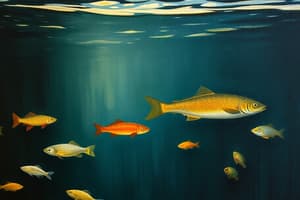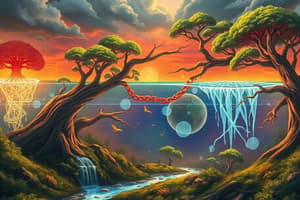Podcast
Questions and Answers
As we move up the food chain of Grass → Grasshopper → Frog → Snake → Hawk, what happens to the available energy?
As we move up the food chain of Grass → Grasshopper → Frog → Snake → Hawk, what happens to the available energy?
- Available energy decreases (correct)
- Available energy increases
- Available energy is zero everywhere
- Available energy remains the same
In the food chain Grass → Grasshopper → Frog → Snake → Hawk, what role does the hawk play?
In the food chain Grass → Grasshopper → Frog → Snake → Hawk, what role does the hawk play?
- Hawk is a consumer and herbivore
- Hawk is a consumer and carnivore (correct)
- Hawk is a producer
- Hawk is a decomposer
The representation of Trees → Birds → Parasites → Hyperparasites is known as what type of pyramid?
The representation of Trees → Birds → Parasites → Hyperparasites is known as what type of pyramid?
- Dumb-bell pyramid of numbers
- Upright pyramid of numbers
- Spindle pyramid of numbers
- Inverted pyramid of numbers (correct)
At the compensation point in photosynthesis, what is the relationship between photosynthesis and respiration?
At the compensation point in photosynthesis, what is the relationship between photosynthesis and respiration?
What is the effect of vegetarianism on supporting large populations, as explained through ecological principles?
What is the effect of vegetarianism on supporting large populations, as explained through ecological principles?
What type of pyramid is represented by Tree → Frugivorous birds → Hawk?
What type of pyramid is represented by Tree → Frugivorous birds → Hawk?
What is the correct relationship between photosynthesis and respiration at the compensation point?
What is the correct relationship between photosynthesis and respiration at the compensation point?
Which type of lake is characterized by low productivity and high oxygen levels?
Which type of lake is characterized by low productivity and high oxygen levels?
In the food chain Grass → Grasshopper → Frog → Snake → Hawk, which statement is true about the number of grasshoppers compared to hawks?
In the food chain Grass → Grasshopper → Frog → Snake → Hawk, which statement is true about the number of grasshoppers compared to hawks?
Net primary productivity is calculated using which formula?
Net primary productivity is calculated using which formula?
Flashcards are hidden until you start studying
Study Notes
Energy Flow in Food Chains
- Energy decreases as you move up the food chain, with only 10% being transferred to each subsequent trophic level (10% Rule).
- This is because energy is lost through processes like metabolism, respiration, and heat production at each trophic level.
Trophic Levels
- Producers are organisms that produce their own food through photosynthesis (e.g., grass).
- Consumers are organisms that obtain energy by consuming other organisms.
- Herbivores are consumers that eat plants (e.g., grasshopper, frog).
- Carnivores are consumers that eat other animals (e.g., snake, hawk).
- Decomposers break down dead organisms and waste products, returning nutrients to the ecosystem (e.g., bacteria, fungi).
Pyramids of Numbers
- Upright Pyramid of Numbers: The number of organisms decreases at each higher trophic level. (e.g., Trees → Birds → Parasites → Hyperparasites)
- Inverted Pyramid of Numbers: The number of organisms in higher trophic levels is greater than in lower levels. (e.g., Tree → Frugivorous birds → Hawk). This is common in scenarios where the producer is large, like a tree, supporting numerous smaller herbivores.
Photosynthesis and Respiration
- Compensation Point: The point at which the rates of photosynthesis and respiration are equal.
- This means that the plant is producing the same amount of energy as it is consuming.
Net Primary Productivity (NPP)
- NPP is the amount of energy that is stored in plant tissues after accounting for respiration losses.
- It is calculated as NPP = APAR × LUE, where APAR is the amount of light energy absorbed by the plant (Absorbed Photosynthetically Active Radiation), and LUE is the plant's Light Use Efficiency (the proportion of absorbed light that is converted into biomass).
Eutrophication
- Eutrophic Lakes: High levels of nutrients, leading to excessive algal blooms.
- Oligotrophic Lakes: Low levels of nutrients, generally very clear water.
- Mesotrophic Lakes: Moderate levels of nutrients, a balance between clear water and algal growth.
- Hypereutrophic Lakes: Extremely high levels of nutrients, leading to severe water quality issues.
Trophic Cascades
- The indirect effects of top predators on lower trophic levels in a food chain. For example, a decrease in the number of predators can have a cascading effect, increasing the number of herbivores and leading to overgrazing impacts on plants.
Energy Flow Through Food Chains
- Energy decreases as you move up a food chain. This is due to the 10% rule, where only about 10% of energy from one trophic level is passed on to the next. The rest is lost as heat.
Trophic Levels
- A hawk is a consumer and carnivore. It occupies the top trophic level and consumes other animals.
Ecological Pyramids
-
Trees → Birds → Parasites → Hyperparasites represents an inverted pyramid of numbers. This is because there are fewer organisms at each higher trophic level.
-
Tree → Frugivorous birds → Hawk represents an upright pyramid of numbers. This implies a higher number of producers at the base, followed by a decrease in each subsequent trophic level.
Photosynthesis and Respiration
- At the compensation point, photosynthesis = respiration. This means the rate of photosynthesis is equal to the rate of respiration, resulting in no net production of organic matter.
Lake Types
- Glacial lakes are typical examples of oligotrophic lakes. These lakes are nutrient-poor and have clear, cold water.
Population Dynamics and Food Chains
- More number of grasshoppers than hawks can be supported. This reflects the concept of energy flow and the 10% rule, where a larger number of organisms at lower trophic levels can be sustained compared to higher levels.
Vegetarianism and Population
- The 10% rule supports the idea that we can support a larger population if we all became vegetarians. This is because there's greater energy available in the food chain lower down, which can be used by humans if they consume plants rather than animals.
Net Primary Productivity
- Net primary productivity (NPP) is calculated by subtracting the energy used for respiration (LUE) from the gross primary productivity (APAR): NPP = APAR - LUE. NPP represents the amount of organic matter created by plants that is available for other consumers in the ecosystem.
Studying That Suits You
Use AI to generate personalized quizzes and flashcards to suit your learning preferences.




